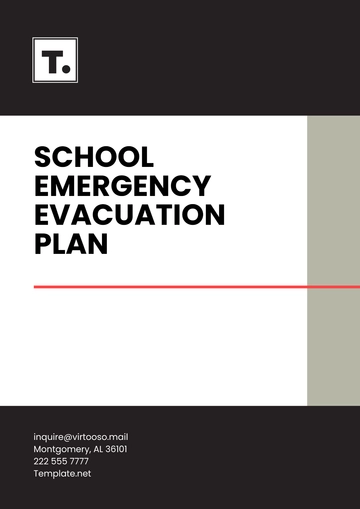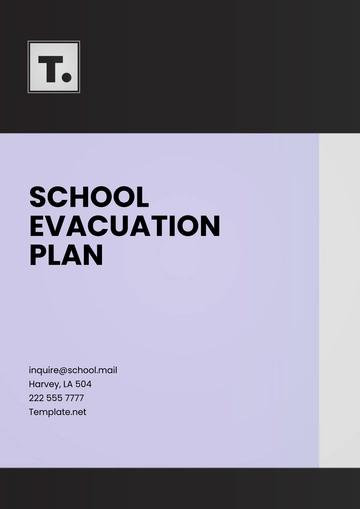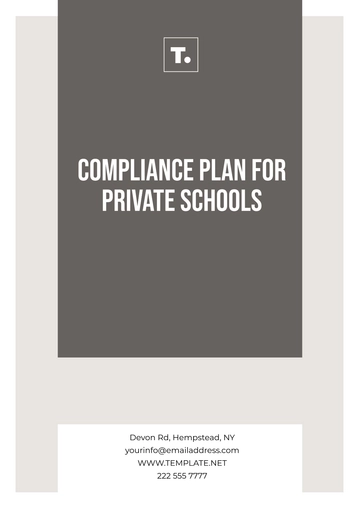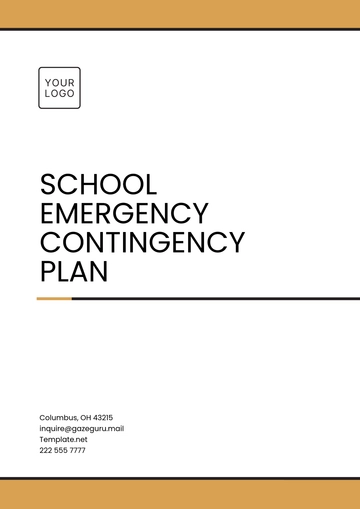Free School Attendance Plan

I. Introduction
This School Attendance Plan aims to boost student attendance in [Your Company Name], ensuring that every child has access to the education they deserve. Regular attendance is critical for academic achievement, social development, and future success. Therefore, this plan outlines a range of strategies, goals, and actions required to increase student attendance rates, thereby improving their overall academic performance and well-being. By fostering a culture of regular attendance, we aim to create an environment where students are eager to learn and thrive.
Given the strong correlation between attendance and academic success, it is vital that we establish a comprehensive strategy that involves students, parents, and staff. This plan emphasizes a collaborative effort to identify and address barriers to regular attendance and implements supportive measures for consistent school participation. We recognize that various factors, including health issues, family circumstances, and socio-economic challenges, can affect attendance. Thus, our approach is holistic, focusing not only on attendance monitoring but also on providing necessary support to students and families.
At [Your Company Name], we believe that every student has the potential to succeed, and regular attendance is a fundamental part of that journey. Through clear communication, community engagement, and targeted interventions, we aim to ensure that all students can attend school regularly. This plan is not just about meeting attendance targets; it is about fostering a supportive and inclusive school environment where every student feels valued and motivated to attend school daily. Together, with the commitment of our entire school community, we can achieve our goal of improved attendance and enhanced student outcomes.
II. Objectives
The primary objectives of the School Attendance Plan are:
To understand and eliminate barriers to regular attendance for all students: By identifying and addressing the factors that contribute to absenteeism, such as health issues, transportation problems, or family circumstances, we can create a more supportive environment that encourages regular attendance.
To foster a culture of attendance and punctuality among students, parents, and staff: By promoting the importance of attendance and punctuality through education and awareness campaigns, we aim to instill a sense of responsibility and commitment to regular school attendance.
To develop and implement intervention strategies for students at risk of chronic absenteeism: By providing targeted support and resources to students who are chronically absent, we can help them overcome barriers to attendance and improve their overall school experience.
Each objective is aimed at ensuring students attend school regularly, thereby receiving the full benefits of the educational programs and resources available to them. Through these objectives, we hope to create a school community that values and prioritizes attendance, ultimately leading to improved student outcomes.
III. Roles and Responsibilities
In order to ensure the successful implementation of the School Attendance Plan, it is essential that all stakeholders understand and fulfill their respective roles and responsibilities. Each stakeholder has a unique role to play in promoting regular attendance and addressing attendance issues. The table below outlines the key responsibilities of each stakeholder:
Stakeholder | Responsibilities |
|---|---|
School Administration |
|
Teachers |
|
Parents/Guardians |
|
Students |
|
Each stakeholder plays a crucial role in supporting regular school attendance and addressing issues as they arise. Collaboration among all stakeholders is essential to the success of the attendance plan and ultimately to the academic success and well-being of the students.
IV. Interventions and Supports
In order to promote regular attendance and address absenteeism effectively, the School Attendance Plan includes a range of interventions and supports. These interventions are designed to target various factors that may contribute to absenteeism and provide students with the necessary support to overcome these challenges. The table below outlines the key interventions and supports included in the plan:
Intervention/Support | Description |
|---|---|
Early Identification | Identify students at risk of chronic absenteeism early through regular attendance monitoring. |
Parental Involvement | Engage parents in supporting their child's attendance through regular communication and support. |
Student Support Programs | Provide access to counseling, mentoring, and other support programs to address attendance issues. |
Community Engagement | Collaborate with community organizations to provide additional support and resources for students. |
These interventions and supports are designed to create a supportive environment that encourages regular attendance and addresses the underlying causes of absenteeism. By implementing these strategies, we aim to improve overall attendance rates and support the academic success of all students.
V. Communication Strategies
Effective communication is essential for promoting regular attendance and addressing attendance issues. The School Attendance Plan includes a variety of communication strategies to engage students, parents, and staff in supporting attendance efforts. These strategies aim to raise awareness about the importance of attendance, provide information about attendance policies and procedures, and facilitate communication between the school and families. The following are key components of our communication strategies:
Regular Communication Channels: [Your Company Name] will utilize various channels to communicate with parents and students, including newsletters, emails, and the school website. These channels will be used to provide information about attendance policies, upcoming events, and resources available to support attendance.
Parent-Teacher Communication: Teachers will communicate regularly with parents regarding their child's attendance and academic progress. This communication will include updates on attendance records, strategies for improving attendance, and opportunities for parents to get involved in supporting their child's education.
Attendance Awareness Campaigns: [Your Company Name] will conduct regular attendance awareness campaigns to highlight the importance of attendance and educate students and parents about the impact of absenteeism on academic success. These campaigns may include posters, presentations, and special events to promote attendance.
Student Involvement: Students will be encouraged to take an active role in monitoring their own attendance and addressing any attendance issues. This may include setting attendance goals, tracking their attendance, and participating in incentives programs to reward good attendance.
Community Engagement: [Your Company Name] will collaborate with community organizations and local businesses to support attendance efforts. This may include providing incentives for good attendance, offering resources for families facing attendance challenges, and raising awareness about the importance of attendance in the community.
Data Sharing: [Your Company Name] will regularly share attendance data with teachers, administrators, and parents to track progress towards attendance goals and identify students who may need additional support. This data sharing will be done in accordance with student privacy laws and regulations.
Feedback Mechanisms: [Your Company Name] will provide opportunities for parents, students, and staff to provide feedback on the attendance plan and suggest improvements. This feedback will be used to continually refine and improve our attendance strategies.
VI. Monitoring and Evaluation
Monitoring and evaluating the effectiveness of the School Attendance Plan is essential to ensure that the strategies and interventions are achieving their intended goals. The plan includes a comprehensive approach to monitoring attendance data, tracking progress towards goals, and evaluating the impact of interventions. The following are key components of our monitoring and evaluation process:
Attendance Data Collection: [Your Company Name] will collect and maintain accurate attendance data for all students. This data will include daily attendance records, as well as information on excused and unexcused absences, tardiness, and early dismissals. Data will be collected in compliance with student privacy laws and regulations.
Data Analysis: Attendance data will be analyzed regularly to identify trends, patterns, and areas for improvement. This analysis will help [Your Company Name] identify students at risk of chronic absenteeism and target interventions accordingly.
Progress Monitoring: [Your Company Name] will track progress towards attendance goals on a regular basis. This will involve comparing current attendance rates to baseline data and assessing the impact of interventions on attendance rates.
Evaluation of Interventions: [Your Company Name] will evaluate the effectiveness of interventions implemented as part of the attendance plan. This evaluation will include collecting feedback from students, parents, and staff, as well as analyzing attendance data to determine the impact of interventions on attendance rates.
Adjustment of Strategies: Based on the monitoring and evaluation findings, [Your Company Name] will adjust strategies and interventions as necessary to improve attendance rates. This may include modifying existing interventions, implementing new interventions, or targeting specific groups of students with additional support.
Reporting: [Your Company Name] will regularly report on attendance data and the effectiveness of interventions to school administrators, teachers, parents, and other stakeholders. These reports will provide transparency about attendance rates and efforts to improve attendance.
Continuous Improvement: [Your Company Name] is committed to continuous improvement of the School Attendance Plan based on monitoring and evaluation findings. This may involve seeking input from stakeholders, conducting further analysis of attendance data, and refining strategies to address attendance issues.
By implementing a robust monitoring and evaluation process, [Your Company Name] aims to ensure that the School Attendance Plan is effective in improving attendance rates and supporting the academic success of all students.
VII. Legal and Ethical Considerations
The School Attendance Plan is guided by a set of legal and ethical considerations to ensure compliance with relevant laws and regulations and to protect the rights and privacy of students and families. The following are key legal matters related to attendance:
Compulsory Attendance Laws: States have laws requiring children to attend school for a certain number of days or hours each year. Schools must comply with these laws and implement strategies to enforce attendance requirements.
Truancy Laws: Truancy laws define truancy and outline consequences for students who are consistently absent without a valid excuse. Schools must follow these laws when addressing truancy issues.
Family Educational Rights and Privacy Act (FERPA): FERPA protects the privacy of student education records, including attendance records. Schools must comply with FERPA regulations when collecting, storing, and sharing attendance data.
Individualized Education Program (IEP): Students with disabilities may have an IEP that includes accommodations related to attendance. Schools must follow the guidelines outlined in the student's IEP regarding attendance.
Ethical Considerations: Schools must consider the ethical implications of attendance policies and interventions, ensuring that they are fair, equitable, and respectful of student and family rights.
Data Security: Schools must implement measures to protect attendance data from unauthorized access, use, or disclosure, in accordance with data security laws and regulations.
Parental Rights: Parents have the right to be informed about their child's attendance and to participate in decisions related to attendance interventions. Schools must respect parental rights when implementing the School Attendance Plan.
Equity and Non-Discrimination: Schools must ensure that attendance policies and interventions are applied equitably to all students and do not discriminate based on race, gender, disability, or other protected characteristics.
Attendance Codes and Categories: Schools must use attendance codes and categories that are consistent with state and district guidelines to accurately track and report attendance.
Attendance Records Retention: Schools must retain attendance records for a specified period of time as required by law and ensure that these records are kept confidential and secure.
By addressing these legal and ethical considerations, [Your Company Name] aims to ensure that the School Attendance Plan is implemented in a manner that is legal, ethical, and supportive of student success.
[Your Company Name] is committed to promoting regular attendance and supporting the academic success and well-being of all students. The School Attendance Plan outlined here emphasizes collaboration, communication, and targeted interventions to address attendance issues effectively. By working together with students, parents, staff, and the community, we believe we can create a positive school culture that values attendance and encourages every student to attend school regularly. Through monitoring, evaluation, and continuous improvement, we will strive to ensure that our efforts result in improved attendance rates and ultimately, better outcomes for all students. Together, we can make a difference in the lives of our students.
- 100% Customizable, free editor
- Access 1 Million+ Templates, photo’s & graphics
- Download or share as a template
- Click and replace photos, graphics, text, backgrounds
- Resize, crop, AI write & more
- Access advanced editor
Improve student attendance with the School Attendance Plan Template from Template.net. This editable and customizable template helps you create detailed and effective attendance plans. Editable in our Ai Editor Tool, it offers a user-friendly experience, making it easy to tailor to your school's specific needs. Promote regular attendance with this essential plan template.
You may also like
- Finance Plan
- Construction Plan
- Sales Plan
- Development Plan
- Career Plan
- Budget Plan
- HR Plan
- Education Plan
- Transition Plan
- Work Plan
- Training Plan
- Communication Plan
- Operation Plan
- Health And Safety Plan
- Strategy Plan
- Professional Development Plan
- Advertising Plan
- Risk Management Plan
- Restaurant Plan
- School Plan
- Nursing Home Patient Care Plan
- Nursing Care Plan
- Plan Event
- Startup Plan
- Social Media Plan
- Staffing Plan
- Annual Plan
- Content Plan
- Payment Plan
- Implementation Plan
- Hotel Plan
- Workout Plan
- Accounting Plan
- Campaign Plan
- Essay Plan
- 30 60 90 Day Plan
- Research Plan
- Recruitment Plan
- 90 Day Plan
- Quarterly Plan
- Emergency Plan
- 5 Year Plan
- Gym Plan
- Personal Plan
- IT and Software Plan
- Treatment Plan
- Real Estate Plan
- Law Firm Plan
- Healthcare Plan
- Improvement Plan
- Media Plan
- 5 Year Business Plan
- Learning Plan
- Marketing Campaign Plan
- Travel Agency Plan
- Cleaning Services Plan
- Interior Design Plan
- Performance Plan
- PR Plan
- Birth Plan
- Life Plan
- SEO Plan
- Disaster Recovery Plan
- Continuity Plan
- Launch Plan
- Legal Plan
- Behavior Plan
- Performance Improvement Plan
- Salon Plan
- Security Plan
- Security Management Plan
- Employee Development Plan
- Quality Plan
- Service Improvement Plan
- Growth Plan
- Incident Response Plan
- Basketball Plan
- Emergency Action Plan
- Product Launch Plan
- Spa Plan
- Employee Training Plan
- Data Analysis Plan
- Employee Action Plan
- Territory Plan
- Audit Plan
- Classroom Plan
- Activity Plan
- Parenting Plan
- Care Plan
- Project Execution Plan
- Exercise Plan
- Internship Plan
- Software Development Plan
- Continuous Improvement Plan
- Leave Plan
- 90 Day Sales Plan
- Advertising Agency Plan
- Employee Transition Plan
- Smart Action Plan
- Workplace Safety Plan
- Behavior Change Plan
- Contingency Plan
- Continuity of Operations Plan
- Health Plan
- Quality Control Plan
- Self Plan
- Sports Development Plan
- Change Management Plan
- Ecommerce Plan
- Personal Financial Plan
- Process Improvement Plan
- 30-60-90 Day Sales Plan
- Crisis Management Plan
- Engagement Plan
- Execution Plan
- Pandemic Plan
- Quality Assurance Plan
- Service Continuity Plan
- Agile Project Plan
- Fundraising Plan
- Job Transition Plan
- Asset Maintenance Plan
- Maintenance Plan
- Software Test Plan
- Staff Training and Development Plan
- 3 Year Plan
- Brand Activation Plan
- Release Plan
- Resource Plan
- Risk Mitigation Plan
- Teacher Plan
- 30 60 90 Day Plan for New Manager
- Food Safety Plan
- Food Truck Plan
- Hiring Plan
- Quality Management Plan
- Wellness Plan
- Behavior Intervention Plan
- Bonus Plan
- Investment Plan
- Maternity Leave Plan
- Pandemic Response Plan
- Succession Planning
- Coaching Plan
- Configuration Management Plan
- Remote Work Plan
- Self Care Plan
- Teaching Plan
- 100-Day Plan
- HACCP Plan
- Student Plan
- Sustainability Plan
- 30 60 90 Day Plan for Interview
- Access Plan
- Site Specific Safety Plan





























